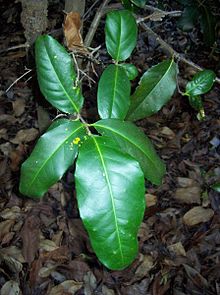- Corynocarpus rupestris
-
Corynocarpus rupestris 
Corynocarpus rupestris subsp. rupestris Conservation status Scientific classification Kingdom: Plantae (unranked): Angiosperms (unranked): Eudicots (unranked): Rosids Order: Cucurbitales Family: Corynocarpaceae Genus: Corynocarpus Species: C. rupestris Binomial name Corynocarpus rupestris
GuymerCorynocarpus rupestris, is an evergreen laurifolia tree, of the family Corynocarpaceae, commonly known as the Glenugie Karaka is a rainforest tree found in eastern Australia.[1] Sub-species arborescens is a small hairless shrub or tree up to 13 metres (45 ft) tall and a stem diameter of 40 cm (16 in) is an evergreen laurifolia tree with large glossy leaves endemic to laurel forest habitat. However, sub-species rupestris grows only to 6 metres (20 ft) and a stem diameter of 17 cm (7 in). It is a rare plant with a ROTAP rating of 2VC-t
Contents
Description
Corynocarpus rupestris is having two sub-species. It is a densely bushy small tree or tall shrub of 2 – 5 m, or a leafy canopy tree that grow to 13 m high with erect or spreading branches. When it is a shrub its trunk is usually multi-stemmed and has smooth, semi-corky bark with broad, shallow fissures. branchlets with prominent scars from scale leaves. The thick, stiff glossy leathery and glabrous leaves are dark green above and paler beneath, 5 to 18 cm long and 3 to 7 cm wide. Leaves usually alternate or in whorls of 3 on juvenile plants, ovate or obovate to lanceolate, The scale leaves of 2–3 mm long are glossy. Leaves on young plants or on the lower parts of adult plants are so strongly and sharply toothed that they appear to be of a different species. Some intermediate leaves are usually present. Leaves are having apex aristate, base decurrent. The margins of leaves are slightly recurved, undulate, entire except for spinose teeth in juveniles. In winter and spring (August to November) it produces a cluster stout, erect of 10 to 21 cm long, of tiny flowers greenish-cream to white or off-white or pale yellow with petioles 10-15 mm long. The individual flowers are 4 to 5 mm in diameter with petals 2.4–3.5 mm long . The pedicels are having 3–5 mm long. The Sepals 2–4 mm long.
The fruit is a rounded or globose drupe red and glossy of 1 to 4 cm diameter, in some sub-species with a tiny point on the end, and have a single kernel with a seed. The fruit ripens in summer and autumn January to April and the seed dispersion is the result of scattering by columbiform birds mostly.
Habitat and ecology
Dry rainforest on steep basalt boulder slopes. Soil is scarce but relatively high in nutrients and very well-drained. Fire is generally excluded by the rocky terrain and absence of ground litter.
With the drying of Australia, the laurel forests habitat gradually retreated, and were replaced by the more drought-tolerant sclerophyll plant communities familiar today. Most of the last remaining laurisilva forests are believed to have disappeared when the clima became drier and with a harsher climate, although some remnants of the laurel forest flora still persist in the mountains of southern are widespread relics of the laurisilva forests that originally covered much more when the climate of the region was more humid. Furthermore, the species was able to adapt to a relatively drier climate with relatively drier summers than those which were themselves. It grows well in limy soils and sheltered position due to its late flowering habit. The grow as a multi-stemmed shrub rather than a tree is an adaptation to this new habitat with well-drained soil and only moderate amounts of water. Corynocarpus rupestris subsp. rupestris, is naturally adapted to dry summers, though also growing well in the cool, wet summers, like to others tertiary lauroides. Corynocarpus rupestris is a typical representative of Laurel forest ecoregion.
Sub-species
- Corynocarpus rupestris subsp. rupestris, Glenugie Karaka.
- corynocarpus rupestris subsp. arborescens, Southern Corynocarpus.
Glenugie Karaka can be distinguished from Corynocarpus rupestris subsp. arborescens or Southern Corynocarpus, by its longer inflorescences, which are 10–21 cm long, and shorter height, as Southern Corynocarpus grows to 12 m hight.
Naming
The word Glenugie comes from the small mountain where sub-species rupestris was collected Glenugie Peak. Karaka is a Maori name from the related New Zealand species Corynocarpus laevigatus. The generic name Corynocarpus means a club fruit, referring to the club shaped fruit of other species in the genus. Rupestris is from the Latin, meaning living near rocks.
References
- ^ Floyd, A.G., Rainforest Trees of Mainland South-eastern Australia, Inkata Press 2008, ISBN 9780958943673 page 106
Categories:- EPBC Act vulnerable biota
- Cucurbitales
- Flora of New South Wales
- Flora of Queensland
- Plant subspecies
- Rosid stubs
Wikimedia Foundation. 2010.

